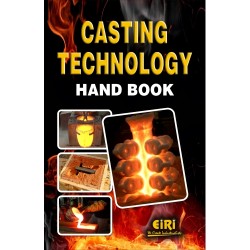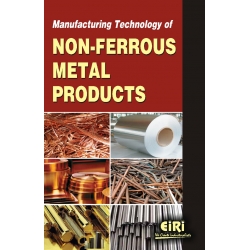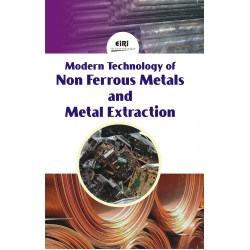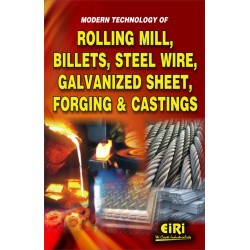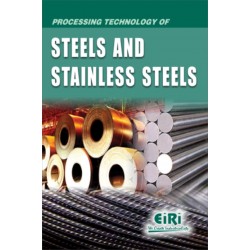Complete Technology Handbook on Automobile Components and Allied Products (Transmission, Clutch, Chassis, Suspension, Battery, Brake, Radiator, Chain, Drive Shaft, Piston, Pin etc)

- More than 40 years of experience
- Managed by expert industrial consultants
- ISO 9001-2015 Certified
- Registered under MSME, UAM No: DL01E0012000
- 24/5 Research Support
Get your quesries resolved from an industry expert. Ask your queries before report or book purchase. - Custom Research Service
Speak to the our consultant to design an exclusive study to serve your research needs. - Quality Assurance
All reports are prepared by highly qualified consultants & verified by a panel of experts. - Information Security
Your personal & confidential information is safe & secure.
Complete Technology Handbook on Automobile Components and Allied Products (Transmission, Clutch, Chassis, Suspension, Battery, Brake, Radiator, Chain, Drive Shaft, Piston, Pin, Piston Ring, Valve, Control Cable, Silencer, Engine Mounting, Auto Lock, Drum, Gear, Leaf Spring, Various Engine Parts, Shock Absorber, Cylinder Block, Tyre & Flaps) with Detailed Manufacturing Process and Project Profiles
Chapter 1
Introduction
Classification of Vehicles
Layout of an Automobile Chassis
Main Components of Chassis
Types of automobile chassis
Full forward chassis
Semi-forward chassis
Bus Chassis
Engine at front chassis
The engine fitted at the rear
The engine fitted in center chassis
Long wheelbase chassis
Overhang Chassis
Half-integral and Half-frame chassis
Components of the Automobile
The Chassis
The Engine
The Transmission System
Clutch
Gearbox
Differential
Axle
The Body
Steering system
Braking system
The Auxiliaries
Chapter 2
Materials used in Automobiles
Metals and Alloys
Steel
Sheet steel
High strength steels
Stainless Steel
Cast Iron
Aluminum
Copper
Magnesium
Lead
Gold
Requirements of the Materials in Automotive
Material properties
Material cost
Material availability
Material compatibility
Material innovation
Material selection tools
Safety, Crashworthiness
Crashworthiness Tests
Frontal Offset Crash Test Detail
Side Impact Crash Testing/Ratings Criterian
Side Barrier Crash Test Scenario
Static Stability Factor
Recycling and Life Cycle Considerations
Current materials in use and their future
Metals
Steel
New grades of steel and alloys
Duplex austenitic-ferritic stainless steel
Austenitic stainless steel
Advances in manufacturing and joining technique
Aluminium
Aluminium alloys for body-in-white applications
Aluminium alloys for brazing sheet applications
Magnesium
Mechanical properties of Mg alloys
Technical problems and solutions for use of magnesium alloys in automotive industry
Plastics and composites
Fabrication
Cost
Manufacturability
Design data/test methodologies
Joining and inspection
Renewable materials, barriers and incentives in use of biocomposites
Thermoplastic/thermoset polymers
Composite processing
Chapter 3
Materials and Technologies for Automotive Use
Introduction
Advanced High Strength Steel (AHSS)
Aluminum Alloys
Carbon Fiber Reinforced Polymer (CFRP)
Light Plastics and Composites
Sustainable Materials
Steel Sheets
High Strength Steel Sheets
New precipitation-hardened high strength hot rolled steel sheet “NANO-Hiten”
New high strength hot rolled steel sheet for strain aging use “BHT”
High strength galvannealed steel sheets
SFG Hiten
Low Carbon Equivalent Type Hiten
High formability ultra-high strength cold rolled steel sheets
High carbon steel sheets with high formability . Coated Steel Sheets
Coated steel sheets with high lubrication for automotive use
Development of Inorganic Type High Lubrication Galvannealed Steel Sheets
Organic Solid Lubricant Technology
Summary
Hot dip galvanized steel sheet with excellent surface appearance
Improvement of Surface Appearance
Surface Roughness Transfer Technologies and Frictional Properties
Summary
Evaluation and Application Technologies for Automotive Steel Materials
Tailor welded blanks
Application technologies of hydroforming
Application technologies for high strength steel sheets in press forming
Application of CAD-CAE systems
High Frequency Electrical Materials for Cars of the Future “Super-Core”
Features of JFE Steel’s Super-Core
JNEX
JNHF
Automotive Applications
Stationary equipment
Rotating machinery
Other electrical applications
Summary
Ferritic Stainless Steels for Automobile Exhaust System Parts
Steels for Mufflers
Steels for Exhaust Manifolds
Steels for Catalytic Converter Substrate
Steel Tubes
HISTORY Tube
High Formability ERW Tubes for Automotive Use
Stainless Steel Tubes for High Temperature Service in Automotive Exhaust Systems
Bar Products for Automotive Use
Bearing Steels “NKJ”, “KUJ7”
Graphite Steel “HFC1 Steel”
BN Free Cutting Steel “CCBN Steel”
High Surface Durable Carburized Dual-phase Steel
High Toughness Microalloyed Steel for Hot Forging
Warm Compaction Method with Die Wall
Lightweight Composite Material for Automotive Headliner “KP Sheet”
Chapter 4
Use of Aluminium in Automobiles
Introduction
Aluminium in Automobile
Advantages of Using Aluminum
Disadvantages of Using Aluminum
Space Frame Technology
Sand Casting
Al-Si Alloys
Grain Refinement
Modification
Extrusion
Al-Si-Mg Alloys
Moment of Inertia
Heat Treatment
Solutionizing
Aging
Annealing
Exposed Loads on Chassis
Static Loads
Dynamic Loads
Fatigue
Welding
Stress Corrosion Cracking
Sand Casting
Spiral Fluidity Test
Mechanical Properties of A356.0 and Silafont-36
Mechanical Properties Change with Heat Treatment
Chapter 5
Use of Plastics in Automobiles: Technology Activities and Priorities
Reducing weight
Energy management technologies
Cost modeling
Polypropylene
Polyurethane
Polyvinyl Chloride
Acrylonitrile Butadiene Styrene
Nylon 6/6
Polystyrene
Polyethylene
Polyoxymethylene
Chapter 6
Manufacturing of Engine Parts
Introduction
Market Potential
Basis and Presumptions
Implementation Schedule
Technical Aspects
Process of Manufacture
Quality Control and Standards
Production Capacity
Pollution Control
Manufacturing Technoloy of Piston Ring
Introduction
Market Potential
Basis and Presumptions
Implementation Schedule
Technical Aspects
Material
Manufacturing Process
Piston Ring Coatings
Production Capacity
Quality Control
Pollution Control
Power Consumption
Manufacturing Technology of Lead Storage Battery
Introduction
Market Potential:
Basis & Presumptions
Implementation Schedule
Technical Aspects
Process of Manufacture
Process Flow Chart Quality Control & Standard
Production Capacity (Per Annum)
Motive Power Required
Pollution Control Requirements:
Energy Conservation
Lighting
Additional Information
Manufacturing Technology of Valve and Valve Seat
Introduction
Introducing Engine Valves
Valve Mechanism and Operation
Intake Stroke
Compression and Power Strokes
Exhaust Stroke
Valve Timing and Overlapping
Engine valve material
Valves sizes
Manufacturing Technology of Automobile Silencer
Introduction
Market Potential
Basis and presumptions
Implementation Schedule
Technical Aspects
Process of Manufacture
Quality Control and Standards
Pollution Control
Energy Conservation
Production Technology of Automobile Chain
Introduction
Market Potential
Basis and presumptions
Implementation Schedule
Technical Aspects
Process of Manufacture
Quality Control and Standards
Pollution Control
Energy Conservation
Manufacturing process of Cylinder Block
Introduction
Functional requirements of an engine block
Material used in engine block casting
Grey cast iron alloys
Aluminum alloys
Compacted graphite cast iron
Tooling required for casting engine block
Manufacturing process of engine block
Theory behind casting
Quality consideration during the production
Possible defects during the production
Production Technology of Cylinder Linear
Introduction
Functions of Cylinder Liners
Formation of Sliding Surface
Reduction of Wear
Heat Transfer
Sealing
Withstanding Combustion
Market & Demand Aspects:
Raw Materials
Manufacturing process & Source of Technology
Basis of Project preperation and Technical aspects
Presumption
Quality Control & Standards
Pollution Control
Advantages of Cylinder Liners
Disadvantages of Cylinder Liners
Production Technology of Automobile Control Cable
Introduction
Market Potential
Basis and Presumptions
Technical Aspects
Process of Manufacture
Implementation Schedule
Process Flow Chart
Quality Control and Standards
Production Capacity
Motive Power
Pollution Control
Production Technology of Engine Mounting PAD
Introduction
Market Potential
Basis and Presumptions
Implementation Schedule
Technical Aspects
Process of Manufacture
Manufacturing Technology of Auto Locks
Introduction
Market
Basis & Presumptions
Implementation Schedule
Technical Aspects:
Process Outline
Quality Control and Standard
Production Capacity
Pollution Control
Manufacturing Technology of Radiator
Introduction
Uses & Market Potential:
Product
Raw Material
Manufacturing Process:
Power Requirement
Assembly Fixtures
Chapter 7
Manufacturing of Automobile Chassis
Manufacturing of automobile Body
Car Manufacturing Process
Body-In-White Concepts
Structural Components
BIW Manufacturing Processes
Blanking and Stamping Processes
Subassembly Processes and Major subassemblies of a BIW
Engine Sub-assembly
Transmission Sub-assembly
Suspension Sub-assembly
Electrical Sub-assembly
Dashboard Sub-assembly
Understanding Sub Assembly In Automotive Manufacturing
Improved Efficiency
Enhanced Quality Control
Streamlined Logistics
Flexibility in Production
Vehicle Sub-assembly
Truck Sub-assembly
The Process of Automotive Sub Assembly
Component Preparation
Sub-Assembly Design
Quality Control and Testing
Sub-Assembly Integration
Documentation and Traceability
Benefits of Sub Assembly in Automotive Production
Streamlined Assembly Process
Enhanced Quality Control
Improved Ergonomics and Worker Efficiency
Supply Chain Management
Cost Savings
Body Framing Process
Door Manufacturing Processes
Rolling and Blanking Processes
Door Fitting
Market Potential
Basis and Presumptions
Implementation Schedule
Technical Aspects
Process of Manufacture
Pollution Control
Energy Conservation
Manufacturing of brake disc
Introduction
The Materials used for the manufacturing process
Equipment/tools used for manufacturing
The Manufacturing Details of Ceramic Composite Brake discs
Quality considerations and defects that would occur in production
Production Technology of Brake Drum
Introduction
Market Potential
Basis and Presumptions
Implementation Schedule
Technical Aspects
Process of Manufacture
Quality Control and Standards
Production Capacity (per annum)
Pollution Control
Manufacturing Technology of Gear Blank
Introduction
Raw Materials
Manufacturing Process
The Process of Flow Chart
Basis of Project Selection:
Presumptions:
Production Capacity
Utilities
Production of Gear Technology
Introduction
Types of Gears and Their Applications
Spur Gears
Helical Gears
Bevel Gears
Worm Gears
Materials Suitable for Making Gears
Mechanical properties
Friction
Manufacturability
Different Gear Manufacturing Processes
Die Casting
Forging
Extrusion and Cold-drawing
Powder Metallurgy
Gear Machining Process
Gear Hobbing
Gear Shaping
Gear Broaching
Gear Milling
How to Choose the Right Gear Manufacturing Process
Gear Manufacturing Post Processing Options
Grinding
Lapping
Honing
Shaving
Gear Shaping
Working of Gear Shaping
Types of Gear Shaping
Applications of Gear Shaping
Advantages and Disadvantages of Gear Shaping
Difference between Gear Shaping and Hobbing
Gear Shaper machine
Pinion cutter gear shaping process
Setup
Working
Gear Shaping by Rack Shaped Cutter
Gear Cutting by Milling
Advantages
Disadvantages
Bevel Gears
Gear manufacture by casting method
Methods of forming gears
Roll forming
Stamping
Powder metallurgy
Extrusion
Gear Generating Process
Gear Hobbing
Typing of hobbing
Arial hobbing
Radial hobbing
Tangential hobbing
Gear shaping (The Fellows process)
Rack-type cutter generating process
Pinion type cutter generating process
Advantages
Disadvantages
Gear cutting by milling
Disc type cutter
End mill cutter
Advantage
Uses
Bevel Gear Generating
Straight Bevel-gear generator
Spiral bevel-gear Generator
Gleason Method
Templet Gear cutting process
Gear finishing process
Gear shaving
Gear grindings
Disadvantage
Gear lopping
Shot blasting
Phosphate coating
Gear planning
The Sunderland process
The maag process
Principal of gear planning
Production of Gear Box Housing
Parts of a car gearbox
Different types of gearboxes in cars
Manual gearbox
Automatic gearbox
Automated Manual Transmission (AMT)
Torque Converter Gearbox
Continuously Variable Transmission (CVT)
Dual Clutch Transmission (DCT)
Functions of the car gearbox
How does a car gearbox work?
Advantages and disadvantages of manual gearbox
Advantages
Disadvantages
Advantages and disadvantages of automatic gearbox
Advantages
Disadvantages
Interesting facts about car gearboxes
Car Gearbox Prototyping and Manufacturing Process
CNC machining
3D Printing
Initial validation and testing
Synchromesh Gearbox
Constant Mesh Gearbox
Preselector Transmission
Production Process of Leaf Spring
Introduction
Parts of Leaf Spring
Metal Plates or Leaves
Master Leaf
Centre Bolt
U-bolt
Rebound Clip
Spring Eye
Shackle
Rubber Bush
Types of Leaf Spring Suspension
Multi-leaf Spring
Mono Leaf Spring
Semi-elliptical Leaf Spring
Quarter-Elliptical Leaf Spring
Three-Quarter Elliptical Leaf Spring
Full Elliptical Leaf Spring
Transverse Leaf Spring
Advantages
Disadvantages
Manufacturing Process
Process Flow Chart
Standard size of Leaf Spring
Material used for Leaf Spring
Pollution Control Measures:
Energy Conservation:
Production Technology of Shock Absorbers
Introduction
Components of a Shock Absorber
Mount
Bushing
Coil Spring
Piston and Piston Rod
Cylinder
Bolts
Additional Small Parts of Shock Absorber
Working Principle of Shock Absorber
Types of Shock Absorbers
Conventional Telescopic Shock Absorbers:
Strut-Type Shock Absorbers
Spring Seat Shock Absorbers
Functions of Shock Absorbers
Symptoms of Bad and Failing Shock Absorber
Advantages of Shock Absorber
Disadvantages of Shock Absorber
Applications of Shock Absorbers
Manufacturing process of shock absorber
Production Technology of Automobiles Tyres
Introduction
Innovations and Advancements in Tyre Manufacturing Technology
Tyre Production Process
Rubber & Compound
Fabric & Steel
The Belt & Ply
The Bead
The Tread
The Sidewall
The Inner Liner
Putting it all together – building the tyre
Curing
Inspection
Environmental Concerns and Sustainability in Tyre Production
Natural Rubber (NR)
Environmental Effects
Mechanical Effects
Oils and Solvents
Synthetic Rubbers
Styrene Butadiene Rubber (SBR)
Butadiene Rubber (BR)
Chloroprene Rubber (CR)
(Acrylo) Nitrile Butadiene Rubber (NBR)
Iso Butylene Isoprene (Butyl) Rubber (IIR)
Ethylene Propylene Rubber (EPDM or EPR)
Silicone Rubber
Chloroprene Rubber
Tread Design
Tread Design Types
Symmetric Tread
Asymmetric Tread
Unidirectional Tread
Tread Elements
Sipes
Blocks
Ribs
Shoulder
Void Ratio
Grooves
Tread Design and Wet Road Conditions
Types of Tyres Used in Cars
All-Season Tyres
Summer Tyres
Winter Tyres
Performance Tyres
Run-Flat Tyres
All-Terrain Tyres
Mud-Terrain Tyres
Emergency Spare Tyres
Space-Saver Tyres
Choosing the Right Tyre for Your Car
Tyre Size
Tyre Tread
Tyre Construction
Driving Conditions
Tyre Profile and Aspect Ratio
Speed Marking of Tyres
How to read a tyre width and the aspect ratio?
How to read a tyre construction type and the wheel diameter?
How to read the maximum load and speed of a tyre?
How to identify the brand name and range of the tyre?
How to identify the type of tyre?
How to read tyre pressure?
How to read a tyre date code?
Manufacturing Technology of Auto Tubes and Flaps
Introduction
Market Potential
Basis and Presumptions
Implementation Schedule
Technical Aspects
Process of Manufacture
Manufacturing Technology of Axle
Importance of Axle strength
Types of Axle
Front axle
Rear axle
Stub axle
Production Process
Forming
Welding assembling
Machining
Axle unit assembly
Chapter 8
Heat Treatments of Automobiles
Introduction
Materials Used In Auto vehicles
Bake Hardening Steel Sheets
High Tensile Strength Steel Sheets
Corrosion Resistant Coated Steel Sheets
Constructional Steels
Case Hardening Steels
Heat Resistant Steels
Powder Metallurgy Products
Copper Alloys
Aluminum Alloys
Magnesium Alloys
Titanium Alloys
Composite Materials
Plastics and Rubber
Glass and Ceramics
Heat Treatment
Types of heat treatment
Processing technology in heat treatment
Carburizing and Carbonitriding
Nitro-carburizing
Induction hardening
Powder Metallurgy and Sintering
Key issue in heat treatment: atmosphere control
Carbon potential control
Gas carburizing processes
Reduced pressure carburizing (Vacuum carburizing)
High Pressure Gas Quenching
Carbonitriding
Low temperature nitrocarburizing and oxynitrocarburizing
Surface modification and hybrid heat treatment
Solid lubricant coatings
Emerging technologies in materials, heat treatment and surface engineering
Materials
Carburizing and carbonitriding
New nitriding methods for aluminum
Nitriding of stainless and maraging steels
Furnaces for heat treatment of fasteners and automobile parts
Washing machine
Hardening furnace
Quenching tank
Continuous hot blast tempering furnace
Capacity of the main furnace
Capacity of the quenching tank
Capacity of the continuous hot blast tempering furnace
Capacity of the dyeing tank
Crucible type annealing furnaces
Application
Features
Specifications of the bell type furnace
Features
Chapter 9
Forging Technology of Automobile Parts
Introduction
Definition of Forging
What is forging?
Materials suitable For Forging
properties of the forgeable materials?
Forgeability
Factors affecting on Forging
Characteristics of forged parts
Forging Process Tools
Types of Forging machine:
Types Of Forging
Open die forging:
Hand Forging
Closed Die forging:
Drop forging
Forging Operation
Operations carried out in forging process
Forging dies
Forging Process Application
Forging Process:
Casting Process
Powder Forging Process
Spanner Forging
Forging Sequence for Spanner
Crankshaft Forging
Other Application
Forging defects with their remedies
Advantages of Forging:
Disadvantages of Forging
Applications of Forging Process:
Chapter 10
Painting Technology of Automobiles
Introduction
Demand for anti-fouling paints for automotive
Increasing demand for foam control agents
Need for mar & stain resistance additives
Spray Priming System
The Beginning
Enamel Paint
Acrylic Lacquer Paint
Acrylic Enamel Paint
Water-Based Paint
Clear Coat Paint
Advancements in Car Paint Technology
Nanotechnology in Paint Formulations
High-Performance Ceramic Coatings
Waterborne Paint Systems
Pearlescent and Chameleon Paints
Digital Printing and Customization
Types of Automotive Paints, Step By Step Painting Process
Stage 1: Applying The Primer - Car Painting – Primer Application
Stage 2: Spraying The Base Coat- Car Painting – Base Coat Spray
Stage 3: Spraying The Clear Coat - Car Painting – Clear Coating
Spray priming system
Dip priming system
Electropriming system
Performance
Pretreatment
Rust removal
Alkali degrease
Metal phosphate (conversion coating)
Pretreatment as a corrosion inhibitor: mechanism
Priming
Spray priming
Dip priming
Products
Pigmentation
Prime pigments:
Extenders
Process
Electropainting
Anodic electrocoat
Resin systems
Pigmentation
Mechanism of deposition
Practical considerations
Basic plant requirements
Control methods
Deficiencies of anodic electrocoat primers
Cathodic electrocoat
Resin system
Pigmentation
Colour
Performance characteristics
Plant requirements
Dip rinsing
Ultrafiltration
Control method
Pretreatment
General appraisal and current developments
Surfacers
Background
Introduction
Product types and formulation
Resins systems
Alkyds
Epoxy esters
Polyesters
Epoxies: film modifiers
Crosslinking resins
Pigmentation
Prime pigments
Extenders
Polyurethane-modified polyester surfacer (including ‘colour keyed’ products)
Summary of basic parameters
Specific gravity (ASTM D1475)
Flash point
Film properties (stoved film)
Appearance
Anti-chip coatings
Background and resin types
Pigmentation
Inverted or reverse process
Electro powder coating (EPC)
Automotive topcoats
Alkyd or polyester finishes
Basic chemistry
‘Sagging’
‘Solvent-popping’ resistance
General properties
Thermosetting acrylic/NAD finishes
Basic chemistry
General properties
Metallic appearance
‘Sagging’
‘Solvent-popping’ resistance
Thermoplastic acrylic lacquers
Basic chemistry
General properties
Basecoat/clear technology
Solvent-borne
Basic chemistry
Application/process
Colour/pigmentation
Painting of plastic body components
Sheet moulded compound (SMC) and dough moulded compound (DMC)
Polyurethane: PU RIM and PU RRIM
Injection moulded plastics
Painting problems
Adhesion
Heat distortion
Surface texture
Solvent sensitivity
Degradation of mechanical properties
Paint processes and products
On-line
Off-line
‘Part-way’ down paint line
Spray application
Air spray
Spray losses
Automatic spray
Low-pressure hot spray
Airless spray
Electrostatic spray
Resistivity
Electrostatic application of water-borne automotive coatings
General plant design features
Paint circulating system for electrical insulation
Externally charged atomizers
Application efficiency - practical considerations and processes
Modern spraybooth design-ventilation modes
Preconditioning the air
Concentrators
Process details: typical application parameters-turbo bells
Stoving procedures
Oven technology
Design considerations of convection ovens
Oven configuration
Oven ventilation
Oven heating
Fresh air requirements
Fuel available/heating method
Fume and odour emission
Thermal incineration
Catalytic combustion
Future stoving developments
Performance/testing
Appearance
Performance
Physical properties
Chemical resistance
Test procedures
Cure (test for crosslinking products)
Sandability (surfacers)
Adhesion: crosshatch test (1.5 mm or 2.0 mm template)
Future developments
High solids technology
Solids range:
Resin types:
Types of product involved:
Higher solids surfacer technology
Application solids
High solids polyester topcoats
Higher solids basecoats
Ultra high solids coatings
Water-borne products
Solids range
Resin types
Product types
Surfacers
Basecoats
Powder coatings and aqueous slurries
Resin types: epoxy, polyester, acrylic
Aqueous powder slurries
Solid colour basecoats
Clearcoats
Pigmentation
Painting of plastics
Electrodeposition and spray application
Chapter 11
Plant Economics of Automotive Engine Valves
Land & Building
Plant & Machinery
Fixed Capital
Working Capital Requirement/Month
Total Capital Investment
Turn Over/Annum
Chapter 12
Plant Economics of Brake Pad and Shoe
Land & Building
Plant & Machinery
Fixed Capital
Working Capital Requirement/Month
Total Capital Investment
Turn Over/Annum
Chapter 13
Plant Economics of Leaf Springs for Tractor Drawn Trolleys & Four Wheeler Tempos
Land & Building
Plant & Machinery
Fixed Capital
Working Capital Requirement/Month
Total Capital Investment
Turn Over/Annum
Chapter 14
Plant Economics of Lithium Ferro Phosphate Battery Pack
Land & Building
Plant & Machinery
Fixed Capital
Working Capital Requirement/Month
Total Capital Investment
Turn Over/Annum
Chapter 15
Plant Economics of Showroom Cum Workshop and Service Centre
Land & Building
Plant & Machinery
Fixed Capital
Working Capital Requirement/Month
Total Capital Investment
Turn Over/Annum
Chapter 16
Plant Economics of Tubeless Valves for Cars and Trucks
Land & Building
Plant & Machinery
Fixed Capital
Working Capital Requirement/Month
Total Capital Investment
Turn Over/Annum
Chapter 17
Plant Economics of Tyre and Tubes Including Flaps
Land & Building
Plant & Machinery
Fixed Capital
Working Capital Requirement/Month
Total Capital Investment
Turn Over/Annum
Chapter 18
Addresses of Machinery and Equipment Suppliers
Chapter 19
Addresses of Raw Material Suppliers
Rubber Chemicals
Carbon Black
Process Oil
Zinc Oxide
Mineral Fillers and Synthetic Rubber
Stearic Acid
How to Make Project Report?
Detailed Project Report (DPR) includes Present Market Position and Expected Future Demand, Technology, Manufacturing Process, Investment Opportunity, Plant Economics and Project Financials. comprehensive analysis from industry covering detailed reporting and evaluates the position of the industry by providing insights to the SWOT analysis of the industry.
Each report include Plant Capacity, requirement of Land & Building, Plant & Machinery, Flow Sheet Diagram, Raw Materials detail with suppliers list, Total Capital Investment along with detailed calculation on Rate of Return, Break-Even Analysis and Profitability Analysis. The report also provides a birds eye view of the global industry with details on projected market size and then progresses to evaluate the industry in detail.
We can prepare detailed project report on any industry as per your requirement.
We can also modify the project capacity and project cost as per your requirement. If you are planning to start a business, contact us today.
Detailed Project Report (DPR) gives you access to decisive data such as:
- Market growth drivers
- Factors limiting market growth
- Current market trends
- Market structure
- Key highlights
Overview of key market forces propelling and restraining market growth:
- Up-to-date analyses of market trends and technological improvements
- Pin-point analyses of market competition dynamics to offer you a competitive edge major competitors
- An array of graphics, BEP analysis of major industry segments
- Detailed analyses of industry trends
- A well-defined technological growth with an impact-analysis
- A clear understanding of the competitive landscape and key product segments
Need Customized Project Report?
- Ask for FREE project related details with our consultant/industry expert.
- Share your specific research requirements for customized project report.
- Request for due diligence and consumer centric studies.
- Still haven't found what you're looking for? Speak to our Custom Research Team
About Engineers India Research Institute:
Our Approach
- Our research reports comprehensively cover Indian markets (can be modified as per your country), present investigation, standpoint and gauge for a time of five years*.
- The market conjectures are produced on the premise of optional research and are cross-accepted through associations with the business players
- We use dependable wellsprings of data and databases. What's more, data from such sources is handled by us and incorporated into the report
Why buy EIRI reports?
- Our project reports include detailed analysis that help to get industry Present Market Position and Expected Future Demand.
- Offer real analysis driving variables for the business and most recent business sector patterns in the business
- This report comprehends the present status of the business by clarifying a complete SWOT examination and investigation of the interest supply circumstance
- Report gives investigation and top to bottom money related correlation of real players/competitors
- The report gives gauges of key parameters which foresees the business execution





















